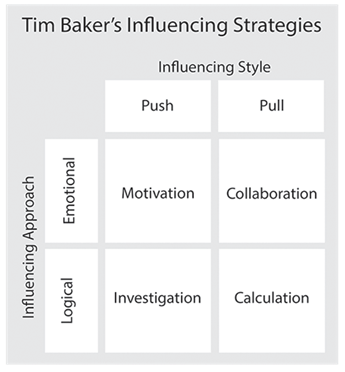
Developing Influencing Skills for Negotiation
To succeed as a team means to hold all of the members accountable for their expertise.
– Mitchell Caplan
Introduction
How frequently have you been in a position where you needed to convince other people to do something?
It is a situation that arises virtually every day, whether it is getting your pre-schooler to get dressed, getting your teenager to clean their room, or getting a co-worker to attend a meeting on your behalf. Others rely on the authority that comes with their position to get what they want, but some people appear to be able to accomplish it easily and virtually without anyone noticing it.
Some common methods people use to influence and convince others are
Nagging – People who try to influence others by constantly talking are familiar to all of us. They appear to have the misguided belief that they can coerce people into submission by merely repeating their viewpoint over and over again. In essence, this is annoying behaviour. It does succeed on occasion, of course, when their co-workers or family members give in only for the purpose of obtaining some tranquillity.

On the other hand, as a matter of thumb, other people who are persuaded in this manner probably have not bought into the notion, and they are not dedicated to it. This indicates that the idea has a high risk of fizzling out and disappearing completely when things become difficult.
Coercion – People rely on the authority that comes with their position to command others to fulfil their whims and desires. This is coercion in the grossest and most unsavoury definition of the word. It’s possible that members of their family or their co-workers won’t approve of what they’re doing. If it is challenging, it is likely that they will give up. More directives are going to be issued in an effort to save the notion, but it’s possible that this time they won’t be successful either. The reason is that the people involved are only acting in this manner because they have to, not because they want to.
A Better Way – The “Holy Grail” of persuasion, then, is to convince people to buy into the idea and desire to execute it your way. This is the goal you should strive for. And the most effective way to achieve so is in a way that passes unnoticed by other people. However, how? A nice illustration of this can be found in the parable of the sun and the wind:
Both the wind and the sun came to the conclusion that a contest was the best way to determine once and for all who was the more powerful of the two. They came to the conclusion that the winner would be the person who was successful in convincing a man to remove his coat. The wind continued to howl, but the man did not loosen his grip on his coat; rather, he pulled it closer to him. After that, the sun began to shine down on the man, and within a few minutes, he removed his coat.
The lesson to be learned from this is that you can’t force someone to do something they don’t want to do; rather, the goal of the art of persuasion is to encourage people to want what you want for themselves.
Brief check
The ability to persuade people to help you reach your goals and objectives is a skill that can be learned just like any other skill, and it is essential to your success in this Endeavour.
Barriers to Successful Persuasion
When trying to convince other people, it can be helpful to first consider what doesn’t succeed before moving on to what does.
In his book titled “Persuasion IQ,” Kurt Mortensen outlines ten challenges that stand in the way of effective persuasion:
-Believing that you are more skilled in persuasion than you actually are and, as a result, not working to improve your abilities. Instead, you should give yourself a thorough examination and pinpoint the areas of your skill set that require development.
– Making too much of an effort to convince others. It’s likely that being too eager is the single most effective way to turn folks off faster than anything else.
-Failure to make the necessary investments in time and energy to achieve one’s goals. In this world, nothing, or at least very little, is free of charge.
-Having too much to say. Put an end to your efforts to convince other people, and just listen to what they have to say.
– Providing an excessive amount of information, which only serves to confuse people and gives them the impression that you are attempting to bamboozle them with scientific language. What, they inquire, is it that you are keeping from them?
-Getting desperate. Fear is another trait that can be detected from a great distance, and people don’t take kindly to it.
-Having a phobia of being turned down. In severe circumstances, this can even prevent people from trying to convince others of their point of view.
-Not being prepared. You can’t just go with the flow in every situation. Your audience will be able to see right through you, and they will believe that you place a higher value on your time than they do.
-Making presumptions about your audience and then failing to be ready to reevaluate those assumptions as new evidence comes to light.
-Ignoring the fact that the entire debate is of significance. In order to convince someone of something, you need to involve them right from the start.
Successful Persuasion
According to the findings of research, there are a number of characteristics that people like in effective persuaders.
According to the findings of Kurt Mortensen’s research, these factors are mostly emotional in nature. Keeping promises, being dependable and accepting responsibility, being sincere, genuine, and honest, knowing their subject and believing in it, building rapport, and being entertaining, as well as not arguing and providing solutions that are effective, are some of the things that fall under these categories.
Therefore, a rather diverse set of abilities is required for effective persuasion. To begin, those who are good at persuasion typically have a healthy sense of self-esteem and, more broadly speaking, a high level of emotional intelligence. They are completely convinced that they will achieve their goals.
In addition to this, you need to keep your motivation up and have faith in both yourself and your ideas. It is also essential that you comprehend the mental processes of your audience.
Brief check
Empathy and strong listening skills, particularly the ability to engage in active listening, are essential in this context.
If you pay attention to what they have to say, your audience will typically tell you what they are thinking and how they feel about it. It is also beneficial to have the ability to create rapport; people appreciate individuals who take the time to become friends in addition to being an influencer. It is only logical that, if we are being truthful with ourselves, we would all prefer to take the advice of a friend rather than someone we despise, regardless of how sound the advice may be. Building rapport also helps to establish trust, and if you want to learn more about how to build trust, check out the page on our website devoted to personal empowerment.
Those that are effective at persuasion or influence also possess very strong communication skills. It is crucial that you are able to get your argument across in a way that is both concise and effective; if you are unable to do so, you will never be able to convince anyone of the validity of your stance.
Being organized is the final ability necessary for effective persuaders. They have done their research, they are aware of the audience, and they are knowledgeable about the topic. They have set aside some time to get themselves organized and to consider the goals that they have set for themselves. Take a look at our sections on Organizational Skills, Strategic Thinking, and Action Planning for further information on this topic.

Developing Persuasion Skills
Being able to convince and influence other people is an essential skill for those in positions of leadership and management; nevertheless, it is also a vital skill to have at home.
The most effective strategy for convincing others of something is to make them want the same thing you do. Nevertheless, figuring out how to achieve that in actual practice might be challenging. It comes more easily to some people, while others have a far more difficult time with it.
The Four Persuasion Strategies developed by Tim Baker and the Influence Weapons developed by Robert Cialdini are two of the models of persuasion that are discussed in this lesson. It is intended to assist you in developing your persuasive abilities in a manner that is somewhat more scientific in nature.
Tim Baker's Persuasion Strategies
In his book, The New Influencing Toolkit: Capabilities for Communicating with Influence, Tim Baker lays out a plan for successfully swaying the opinions of other people and provides a framework for doing so. The model outlines not one but two distinct ways of exerting influence over others, as well as two distinct strategies for doing so.
Having an impact on style: Push/Pull
When using a “push” method of influence, the one doing the exerting the influence is expected to “push” information onto other individuals. It is a method of communication that is very straightforward and is frequently used in a very authoritative manner.
The technique of exerting influence through the use of pull is more covert and indirect. Instead of leading to the solution, it hints at what the solution might be, such as by pointing out the drawbacks of the present circumstance.
The Logical vs. Emotional Approach to Influencing Behavior
Taking a logical approach involves making an argument based on reason, which means that it engages the mind. People that are good at logical persuasion typically rely on facts, figures, and being “correct.” The emotional approach operates through the expression of sentiments and, as a result, makes an appeal to the “heart.” The listener needs to have a “good gut feeling” about it.
Brief check
Logical and emotional appeals are the two methods that can be used to influence people.
This framework developed by Tim Baker combines the following four distinct methods of persuasion, which are derived from the two distinct leadership styles and methods:

- Motivators
Motivators tap into people’s feelings and have a natural talent for crafting compelling visions.
They laid out their position very clearly, demonstrating to those who they want to convince how the world could be, so boosting morale in the process.
“We choose to go to the moon…not because it is easy, but because it is hard…” by John F. Kennedy is a great example of how motivation can be effectively used to persuade others. Martin Luther King’s “I have a dream…” speech is another great example of how motivation can be effectively used to persuade others. This type of language is frequently used in political discourse due to the fact that a significant number of political choices are not determined by logic but rather by political opinions and emotions.
- Collaborators
Collaborators also use emotion, however in contrast to motivators; collaborators view themselves as equal partners in the decision-making process alongside others.
Collaborators have a strong belief in the concept of engaging “hearts and minds,” which means getting people to buy into the outcome by having them participate in decision-making. They cultivate relationships, earn one another’s trust, and speak in an extremely open manner.
Because people who contribute to the success of a group are less likely to seek credit for their efforts, there are less obvious examples of collaborators than there might otherwise be. On the other hand, Tim Baker believes that Mother Teresa was a team player who was successful in convincing others of the significance of reducing levels of poverty in the world.
- Investigators
It is important for investigators to have access to all of the facts and data, and they often use this information to convince others.
Their approach is typically fairly planned and thorough, and they like the opportunity to guide individuals step by step toward the resolution they have in mind. They focus heavily on collecting evidence, expressing ideas, and making use of statistics to counteract any arguments that may be presented.
This can be quite effective if you are working with the correct group of individuals; but, it can also lead to the assumption that you are attempting to “blind people with science.” When it comes to his work on climate change, Al Gore, a former Vice President of the United States, can be described as something of a calculator.
Calculators
Calculators have a tendency to offer both the good advantages of altering and the negative features of the status quo at the same time.
They consider all of the possibilities and make concessions in areas where they believe they have the financial flexibility to do so. Margaret Thatcher, who served as prime minister of the United Kingdom in the past, was an excellent analyst.
Using Baker’s Strategies Like Leadership Styles, each of these styles has the potential to be successful in specific contexts.
For instance, collaborators may prove to be very useful in professional organizations like schools and hospitals, which place a greater emphasis on professional respect than line management systems.
However, good persuaders and influencers will utilize all four techniques, to mix passion and reasoning in the most potent way, and to make sure that they appeal to everyone. This is because effective persuaders and influencers will employ all four strategies in many different scenarios.
Because of this, it is essential to not only comprehend and be able to implement each of these methods when required but also to combine them in a natural and fluid manner.
Influence on moral grounds
As you hone your ability to persuade others, it is imperative that you keep in mind that you must always do so in an honest and upstanding manner. It is never a good idea to try to convince other individuals to engage in behaviour that is unlawful or that is actively working against their interests while serving yours.
Inevitably, there will be occasions in which you will have to convince others to engage in an activity that presents a challenge or that is challenging for them, simply because doing so is in the best interests of the organization or of the larger group.
Convincing others of the significance of mitigating the effects of climate change is a good example of this, as is gaining support for a significant change initiative that will result in the elimination of some positions, but will position the organization to fulfill its goals well into the foreseeable future. This does not violate any ethical standards, but you do need to strike a balance between the requirements of the individual and those of the group.

Influence Tools Developed By Robert Cialdini
In his book, “Influence: The Psychology of Persuasion,” Robert Cialdini outlines six different “influence weapons” that can be used to assist in the process of swaying the opinions of others. This makes the act of persuasion sound more like a fight or a war, which may not be altogether helpful (the creation of a situation in which both parties benefit will almost always be more successful).
However, if you find yourself in a scenario where you need to consider your options, the following six suggestions can prove to be helpful.
Reciprocity
One way to think about this is in terms of the proverb “you scratch my back, I’ll scratch yours.” In other words, if you do this favour for me right now, I will return the favour to you at some point in the future. You will, of course, have to be ready to repay the favour at some point in the future. Should you fail to do so, it is likely that your capacity to employ this strategy in the future would be restricted.
Commitment and Regularity are required
If you can convince individuals to make a promise, whether it be in public or simply to you, they are much less likely to back out of it afterwards. This is especially true if they made the commitment in public.
Brief check
We prefer to believe that when we make a commitment, it is important: the phrase "My word is my bond" comes to mind in this context. We also desire to be viewed as consistent. Although these concepts may be considered archaic, there is no denying their potency and usefulness.
Evidence from Society
The concept of “strength in numbers” is at the heart of social proof. It is a reflection of both “herd mentality” and laziness: if someone else has done all the research and concluded that product A is the best, then why do all the research again? This is a reflection of both. This idea is what motivates people to leave testimonials on websites and in brochures, and it explains why we want to look for information on social media before making a purchase of any kind.
Liking
This has two components: having feelings for someone and mirroring their characteristics. When someone we like is trying to convince us of anything, we are more likely to be receptive to their argument. Therefore, it is worthwhile to devote time in creating relationships, which is, of course, consistent with the Collaborator strategy developed by Tim Baker. It is much easier to create rapport and relationships with someone when you can demonstrate that you are similar to them, such as by demonstrating that you share preferences and values. This is an aspect of what we mean by this.
When you have authority over a situation, you have the potential to influence others merely by virtue of your position. When you hold a position of power, you have the ability to direct the actions of others. This is a tactic that has proven to be highly effective in the military, but it can also be applied to any marketing effort that relies on so-called “experts” to explain the advantages of a particular product. However, because you cannot stand over people indefinitely, this tactic for achieving long-term success as a manager or leader is one that has a rather limited window of applicability. You are going to have to put your faith in them at some point in order for them to complete the task, and it is quite unlikely that they will do so if they are just complying with your instructions because they recognize that you are the one in charge.
Scarcity
The last and most effective ‘weapon’ is convincing others that something is valuable due to the fact that it is scarce. When a salesperson says something like “Only five more left – buy now!” or “Limited period only,” they are using this phrase. This plays on people’s anxieties about missing out, which is a very powerful emotion; nonetheless, it must be utilized with caution. If you do it on a personal level too frequently, it will eventually lose some of its effectiveness.
These two examples of alternative models of influence strategy are just two of many that are available to you. There are, without a doubt, a great number of others out there. Exploring them will assist you in thinking through different frameworks and concepts, and will also help you become more conscious of the tactics you like to use on your own. You can become a more powerful influencer by expanding the scope of your knowledge and experience.
Negotiating on Behalf of Someone Else
There are several unique difficulties that arise while negotiating on behalf of another party. You need to have a crystal clear notion of your Walk Away Price (WAP) and the compromises you have permission to make before you begin such a discussion. You should also make sure that you grasp the topics to the point where you can give convincing answers to challenging inquiries that may be posed during the negotiation. If you are putting together a group of people to assist you in the negotiation, you need to choose members of that group who have the experience as well as the disposition to move the negotiation along.
In some respects, it is comparable to the process of selecting an army unit. When you go into battle, you want to make sure that you have individuals close by who will look out for your best interests and protect you from harm. One of the most useful principles to bring into discussions is the idea that a chain is only as strong as its weakest link. There is a proverb that says a chain is only as strong as its weakest link.
Choosing Who Will Represent You in Negotiations
Information sharing is a fundamental component of effective leadership of any kind of group. To be successful, teams require access to information. Hold a meeting with the team before the negotiation so that everyone can make sure they have the information they need to effectively contribute to the conversation. You can also use these meetings to:
- Remind everyone of the goals the team has set for itself.
- Ensure that everyone understands his or her role in the negotiation.
- Create a “game plan” for the negotiation.
You do not want to go into negotiations with a group that includes someone who is oblivious to their role or the overarching purpose of the endeavour. In the event that there is a lack of confidence among the members of the team, word will quickly spread, and your co-workers will undoubtedly pick up on it. Because of this, you may find that your ability to negotiate is severely limited. This is due to the fact that a team that has a clearly defined brief and all of its members fully apprised of the plan will be in a better position to coerce concessions from a team that has chaos in its ranks. During any type of negotiation, it will be beneficial to your cause to have a team that has clearly defined roles as well as a clearly defined goal.
When it comes to in-depth negotiations, the more people you have on your side (provided that they conduct themselves in a professional manner and are aware of their position), the more talents you will have at your disposal and the more room for manoeuvrability you will have. You want a situation in which “two heads are better than one” rather than one in which “too many chefs spoil the broth,” because that’s what you want to happen.
Brief check
When it comes to certain types of negotiations, the number of issues at play can be overwhelming for a single person to comprehend. In circumstances like these, it is beneficial to put together a group of knowledgeable individuals to ensure that every angle is covered. The ability to persuade people to help you reach your goals and objectives is a skill that can be learned just like any other skill, and it is essential to your success in this Endeavour.
Taking Care of Everything Necessary
It is essential for every member of any team to have a comprehensive understanding of his or her duties and responsibilities. What can be gained through having a dedicated team that is designed to achieve the best negotiating muscle can be lost through having people who are unclear on what they can and cannot deliver or who are unaware of their roles.
It is advantageous to have a team that has the perception that they can make decisions with a certain degree of independence. Because of this, they will be able to negotiate more naturally and without as much anxiety about going too far past the point where they should be. However, because they are not negotiating on their own behalf, it is necessary to place some restrictions on the amount of freedom they enjoy. In each of these scenarios, there is a requirement for a sense of equilibrium. They will have no leverage in the negotiation process if they believe that their hands are tied and that they cannot make a decision without consulting with you first.
If they believe that they have complete autonomy and can act in any manner they see fit, it is possible that they will make a decision that you would not have chosen to make and that is detrimental to your position. It is essential to arrive at a compromise that allows you to feel secure in the knowledge that their choices will be to your advantage.
Complex negotiations have a propensity to fail or result in an agreement that is unpopular if they are not handled correctly and with a sense of common purpose. It is important to find the right balance, as it is the case with so many different issues, because these negotiations have a tendency to fail or result in an agreement that is unpopular. If you have the right people on your team, you can at least make sure that you are not the one who ends up with an unpopular deal on your hands during the negotiation process.
Confronting Challenging Issues and Questions
The following are some of the possible responses that you could give to questions that you choose not to answer:
- In a cordial manner, imply that the question is not pertinent to the discussion. You could, for instance, say something along the lines of “I’m not sure how that question fits in here.”
- Admit that you are unsure of the answer. If you are truly unsure of the answer, you should proceed in this manner. It is the most appropriate course of action. This method is superior to making educated guesses. As the next step, you might tell the person who asked the question that you will look into the matter and get back to them within a couple of days with an answer.
- You should state that you would prefer to wait until a later point in the negotiation to provide a response to the question. It is in your best interest to proceed in this manner if your response will disclose too much about your position too soon.
- In response, you should ask a question of your own. It’s possible that this will help shed some light on the questioner’s intentions. (What exactly is the questioner trying to get at?)
Without giving an answer that will put you at a disadvantage in terms of negotiations, you can take the question in stride and give the appearance of giving it the consideration it merits by using any one of these approaches. People might try to trip you up by asking you challenging questions, or they might do so because they are unsure of their own position and are looking for a way to make it more clear. It will be important how you respond to questions like these, but as long as you demonstrate certainty and a desire to be straightforward with them, there is no need for you to lose confidence.
Conclusion
It will take some time, but if you master these talents, you will start to develop what is referred to as “genuine power.” This power comes from the fact that other people believe what you are saying. When you have it, you will likely have a great deal more success in convincing and influencing other people, whether you are doing it at home or at your place of employment.

Practical Application
This is a practical example of influencing without being seen. Consider the following scenario, in which a group of students is tasked with selecting a leader for the group project.
The group had reached a consensus on the characteristics of the ideal person, and Sue and Steven stood out as the most obvious possibilities among the group’s members.
Sue made the suggestion that Steven should take on the responsibility, and he gladly accepted. Decision made. Everyone in the group grinned, with the exception of one individual named John.
John, who had been silent up until that point, finally spoke up and said, “Steven, don’t forget to let us know what you want us to do to help. You’re going to have a lot on your plate now that you have a new job, and if you don’t make sure you organize everything for us, we won’t be able to get everything done.”
After pausing for a moment to consider, Steven then said to the audience, “You know, on reflection, I’m not sure I’ve had the time to do this in addition to starting my new job.” As you said, I have a lot going on right now. Maybe it would be better if Sue did it.”
Everyone turned their attention to Sue, who then announced that she would volunteer to do it if the others in the group so desired. They were all in agreement that that would be the greatest option.
After some time had passed, Sue approached John in secret and inquired as to the reason of his intervention after the group had already chosen a leader. He expressed his belief that she would be able to perform the task more effectively than Steven and bring about an improved outcome for the team.
In the preceding scenario, John was able to acquire what he desired by making extremely subtle use of his persuasive abilities. As a result, he turned a potentially contentious discussion into a situation in which both parties benefited.
Steven was pleased that the group had recognized his abilities, and he was also pleased that he would not be in charge of the Endeavour.
In point of fact, he indicated in the end that he desired Sue to take charge of it, and John never needed to take the risk of upsetting him by stating that he believed Sue would be a more effective leader.





